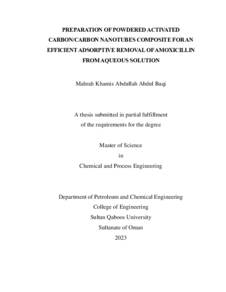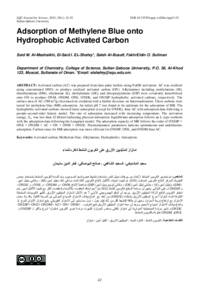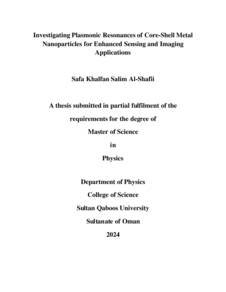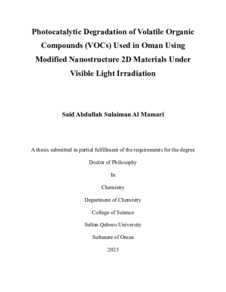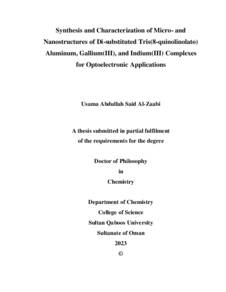Document
Preparation of powdered activated carbon/carbon nanotubes composite for an efficient adsorptive removal of amoxicillin from aqueous solutions.
Other titles
تحضير مسحوق الكربون المنشط/الأنابيب النانوية الكربونية من أجل إزالة فعالة لامتصاص الأموكسيسيلين من المحاليل المائية
Publisher
Sultan Qaboos University.
Gregorian
2023
Language
English
English abstract
This study explores the feasibility of amoxicillin removal, via adsorption, from synthetic
wastewater resembling pharmaceutical waste. Carbon nanotubes on powdered activated
carbon substrate, that include potassium hydroxide, were synthesized using chemical
vapor deposition method. The synthesized nanoparticles were then functionalized using
nitric and sulfuric acid mixture to enable dispersion and better interaction with the targeted
contaminant which was later used as adsorbent to remove amoxicillin from the aqueous
solution. Characterization for the synthesized nanoparticles was conducted using Fourier
transform infrared spectrum, x-ray diffraction, scanning electron microscopy and
thermogravimetric analysis. The characterization results showed that carbon nanotubes
were successfully fabricated. The results also exhibited that carbon nanotubes retained
their structure after acidic treatment. In addition, surface characterization using FTIR
results confirm the addition of oxygen containing group to the surface of the nanoparticles.
Besides that, good crystallinity and thermal stability was achieved.
In this work, pH, temperature, adsorbent dosage, contact time and stirring speed were
investigated. It was found that the adsorption capacity has a proportional relationship with
temperature highlighting the endothermic nature of the adsorption process. On the
contrary, adsorption capacity was found to be inversely proportional to pH. Adsorption
capacity decreased with the increase of adsorbent dosage but at the same time increase in
adsorbent dosage leads to an increase in removal efficiency, so proper dosage selection
requires considering both adsorption capacity and removal percent. However, stirring
speed showed insignificant effect on the adsorption capacity with a slight improvement at
high temperature. The results showed that functionalized nanoparticles pose high removal
efficiency of amoxicillin in the aqueous solution with a maximum adsorption capacity of
357.14 mg/g once a model solution of 500 ppm amoxicillin concentration was used. The
optimum conditions for kinetic, pH and temperature were found to be 6 hours, pH of 2
and temperature of 40 ˚C, respectively. While maximum adsorption capacity of 250 mg/g
in 5 hours, at pH of 2 and temperature of 50 ˚C were obtained when a model solution of
100 ppm amoxicillin concentration was tested.
Kinetic, isothermal, and thermodynamic models were also investigated during this study.
The models revealed an endothermic nature of the adsorption process and formation of a
monolayer of amoxicillin molecules in the adsorbent surface. The models suggests that
chemisorption is the main adsorption mechanism. Further investigation on adsorbent
regeneration and reusability showed that adsorbent was best regenerated using sodium
hydroxide, the adsorbent maintained good adsorption capacity after two consecutive
adsorption desorption experiment.
Member of
Resource URL
Arabic abstract
تستكشف هذه الدراسة جدوى إزالة الأموكسيسيلين ، عن طريق الأمتزاز ، من مياه الصرف الصناعي التي تشبه النفايات الصيدلانية تم تصنيع الأنابيب النانوية الكربونية على ركيزة الكربون المنشط المسحوق ، والتي تشمل هيدروكسيد البوتاسيوم ، باستخدام طريقة ترسيب البخار الكيميائي. تم بعد ذلك تشغيل الجسيمات النانوية الُمصنَّعة باستخدام خليط حامض النيتريك والكبريتيك لتمكين التشتت والتفاعل الأفضل مع الملوث المستهدف الذي تم استخدامه ا كممتاز لإزالة الأموكسيسيلين من المحلول المائي. تم إجراء توصيف للجسيمات النانوية المركبة باستخدام طيف الحقً الأشعة تحت الحمراء لتحويل فورييه ، وحيود الأشعة السينية ، والفحص المجهري الألكتروني والتحليل الحراري الوزني. أظهرت نتائج التوصيف أن الأنابيب النانوية الكربونية تم تصنيعها بنجاح. أظهرت النتائج أيضا أن الأنابيب النانوية الكربونية احتفظت بهيكلها بعد المعالجة الحمضية. بالأضافة إلى ذلك ، يؤكد توصيف السطح باستخدام نتائج تحت الحمراء لتحويل فورييه إضافة مجموعة تحتوي على الأكسجين إلى سطح الجسيمات النانوية. بالأضافة إلى ذلك ، تم تحقيق تبلور جيد واستقرار حراري. في هذا العمل تم فحص الأس الهيدروجيني ودرجة الحرارة وجرعة الممتزات ووقت التالمس وسرعة التحريك. وجد أن سعة الأمتزاز لها عالقة تناسبية مع درجة الحرارة مما يبرز الطبيعة الماصة للحرارة لعملية الأمتزاز. على العكس من ذلك ، وجد أن سعة الأمتزاز تتناسب عكسياًمع الرقم الهيدروجيني. تقل قدرة الأمتزاز مع زيادة جرعة الممتزات ولكن في نفس الوقت تؤدي الزيادة في جرعة الممتزات إلى زيادة كفاءة الأزالة ، لذلك يتطلب اختيار الجرعة المناسب النظر في كل من قدرة الأمتصاص ونسبة الأزالة. ومع ذلك ، أظهرت سرعة التحريك تأثيرا ضئيلا على قدرة الأمتصاص مع تحسن طفيف عند درجة الحرارة العالية. أظهرت النتائج أن الجسيمات النانوية الوظيفية تشكل كفاءة عالية في إزالة الأموكسيسيلين في المحلول المائي مع قدرة امتصاص قصوى تبلغ ٣٥٧٫١٤ مجم / جم بمجرد استخدام محلول نموذجي قدره ٥٠٠ جزء في المليون من تركيز أموكسيسيلين. تم العثور على الظروف المثلى للحركية ودرجة الحموضة ودرجة الحرارة لتكون ٦ ساعات ودرجة الحموضة ٢ ودرجة الحرارة ٥٠ درجة مئوية على التوالي. بينما تم الحصول على قدرة امتصاص قصوى تبلغ ٢٥٠ مجم / جم في ٥ ساعات ، عند درجة حموضة ٢ ودرجة حرارة ٥٠ درجة مئوية عندما تم اختبار محلول نموذجي بتركيز ١٠٠ جزء في المليون من أموكسيسيلين. كما تم فحص النماذج الحركية ، متساوي الحرارة ، والديناميكا الحرارية خالل هذه الدراسة. كشفت النماذج عن طبيعة ماصة للحرارة لعملية الأمتزاز وتشكيل طبقة أحادية من جزيئات الأموكسيسيلين في سطح الممتزات. تشير النماذج إلى أن الأمتصاص الكيميائي هو آلية الأمتزاز الرئيسية. أظهر المزيد من التحقيقات حول تجديد الممتزات وقابليتها إلعادة الأستخدام أن المادة الماصة تم تجديدها بشكل أفضل باستخدام هيدروكسيد الصوديوم ، حيث حافظت المادة الماصة على قدرة امتصاص جيدة بعد تجربتين متتاليتين لامتصاص الأمتصاص.
Category
Theses and Dissertations

